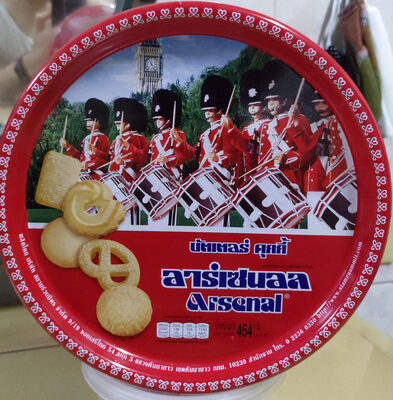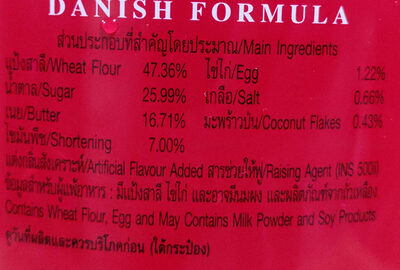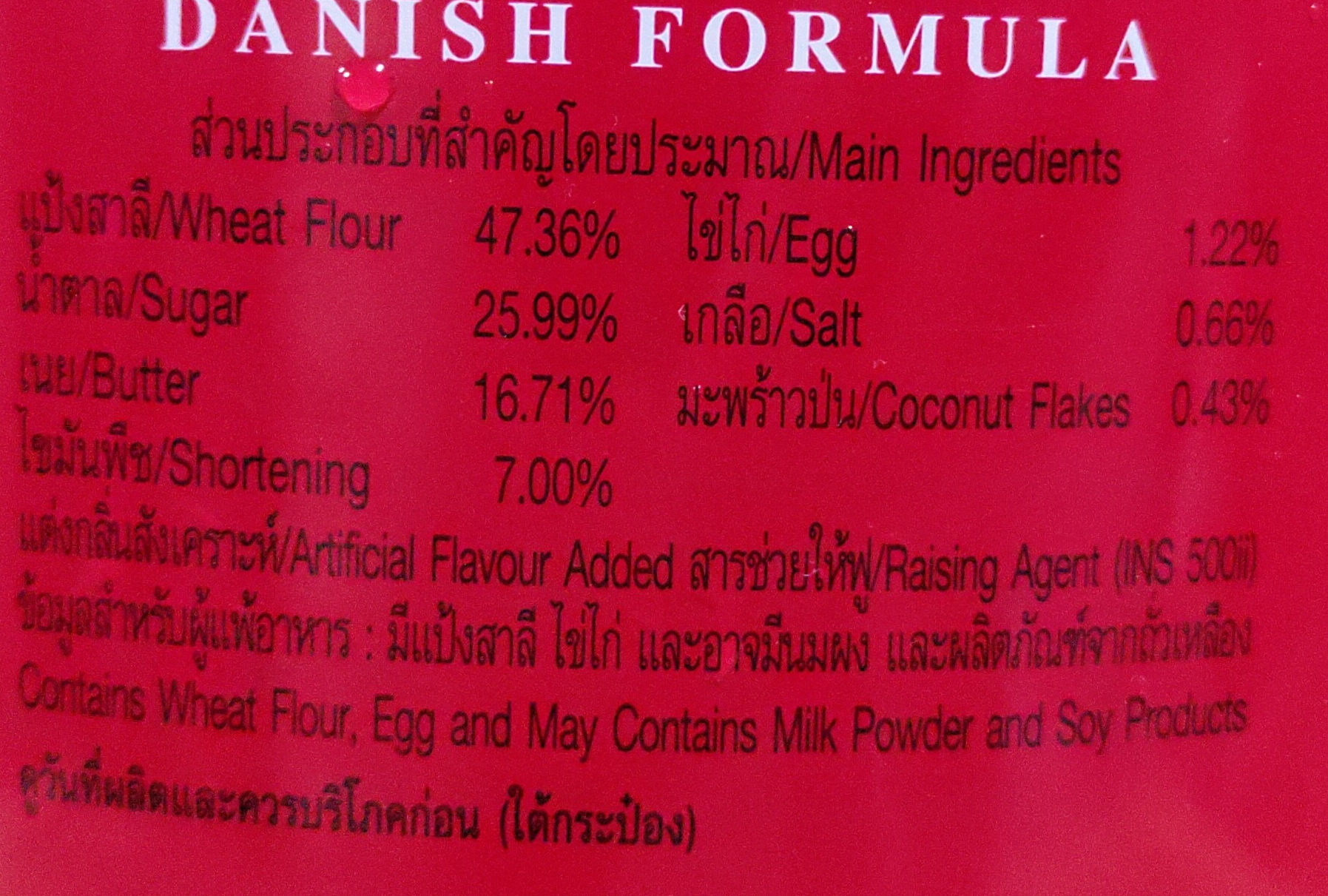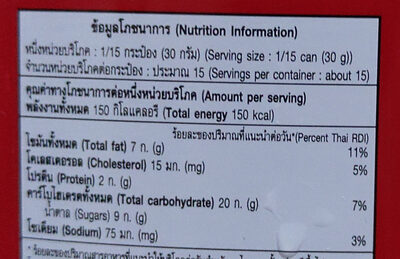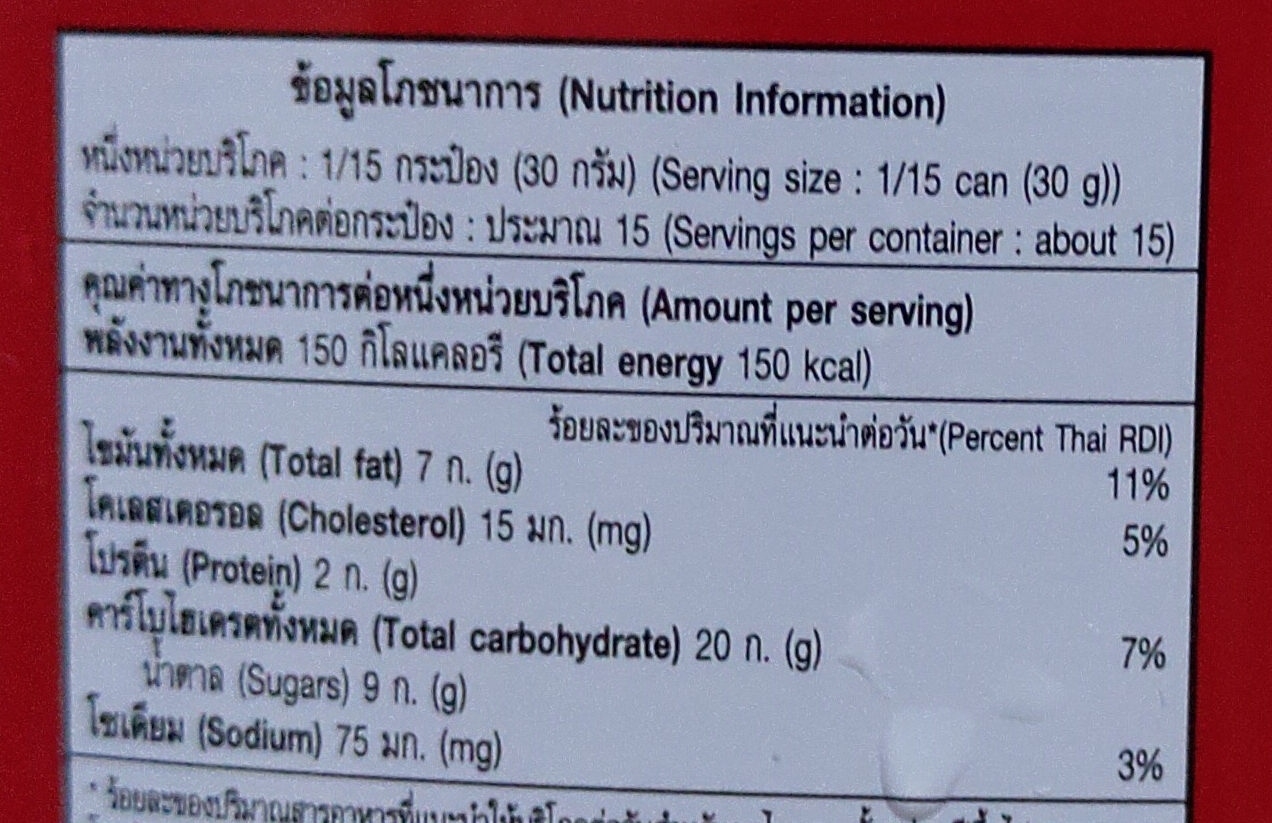Help us make food transparency the norm!
As a non-profit organization, we depend on your donations to continue informing consumers around the world about what they eat.
The food revolution starts with you!
อาร์เซนอล บัตเตอร์ คุกกี้ - 454 g
อาร์เซนอล บัตเตอร์ คุกกี้ - 454 g
This product page is not complete. You can help to complete it by editing it and adding more data from the photos we have, or by taking more photos using the app for Android or iPhone/iPad. Thank you!
×
บาร์โค้ด: 8852052130509 (EAN / EAN-13)
ปริมาณ: 454 g
บรรจุภัณฑ์: en:Box
ยี่ห้อสินค้า: อาร์เซนอล, Arsenal
หมวดหมู่: ขนม-ของว่าง, en:Sweet snacks, ขนมปังกรอบและเค๊ก, บิสกิต, en:Petit-Beurre
ประเทศที่ขาย: ประเทศไทย (Thai)
Matching with your preferences
Health
ส่วนผสม
-
12 ingredients
Wheat Flour 47.36%, Egg 1.22%, Sugar 25.99%, Salt 0.66%, butter 16.71%, Coconut Flakes 0.43%, Shortening 7%, Artficial Flavour Added, Raising Agent (INS 500i) Contains Wheat Flour, Egg and May Contains Milk Powder and Soy Productsสารก่อภูมิแพ้: กลูเต็นTraces: ไข่, นม
Food processing
-
Food processing level unknown
Food products are classified into 4 groups according to their degree of processing:
- Unprocessed or minimally processed foods
- Processed culinary ingredients
- Processed foods
- Ultra processed foods
The determination of the group is based on the category of the product and on the ingredients it contains.
สารปรุงแต่งอาหาร
-
E500
Sodium carbonate: Sodium carbonate, Na2CO3, -also known as washing soda, soda ash and soda crystals, and in the monohydrate form as crystal carbonate- is the water-soluble sodium salt of carbonic acid. It most commonly occurs as a crystalline decahydrate, which readily effloresces to form a white powder, the monohydrate. Pure sodium carbonate is a white, odorless powder that is hygroscopic -absorbs moisture from the air-. It has a strongly alkaline taste, and forms a moderately basic solution in water. Sodium carbonate is well known domestically for its everyday use as a water softener. Historically it was extracted from the ashes of plants growing in sodium-rich soils, such as vegetation from the Middle East, kelp from Scotland and seaweed from Spain. Because the ashes of these sodium-rich plants were noticeably different from ashes of timber -used to create potash-, they became known as "soda ash". It is synthetically produced in large quantities from salt -sodium chloride- and limestone by a method known as the Solvay process. The manufacture of glass is one of the most important uses of sodium carbonate. Sodium carbonate acts as a flux for silica, lowering the melting point of the mixture to something achievable without special materials. This "soda glass" is mildly water-soluble, so some calcium carbonate is added to the melt mixture to make the glass produced insoluble. This type of glass is known as soda lime glass: "soda" for the sodium carbonate and "lime" for the calcium carbonate. Soda lime glass has been the most common form of glass for centuries. Sodium carbonate is also used as a relatively strong base in various settings. For example, it is used as a pH regulator to maintain stable alkaline conditions necessary for the action of the majority of photographic film developing agents. It acts as an alkali because when dissolved in water, it dissociates into the weak acid: carbonic acid and the strong alkali: sodium hydroxide. This gives sodium carbonate in solution the ability to attack metals such as aluminium with the release of hydrogen gas.It is a common additive in swimming pools used to raise the pH which can be lowered by chlorine tablets and other additives which contain acids. In cooking, it is sometimes used in place of sodium hydroxide for lyeing, especially with German pretzels and lye rolls. These dishes are treated with a solution of an alkaline substance to change the pH of the surface of the food and improve browning. In taxidermy, sodium carbonate added to boiling water will remove flesh from the bones of animal carcasses for trophy mounting or educational display. In chemistry, it is often used as an electrolyte. Electrolytes are usually salt-based, and sodium carbonate acts as a very good conductor in the process of electrolysis. In addition, unlike chloride ions, which form chlorine gas, carbonate ions are not corrosive to the anodes. It is also used as a primary standard for acid-base titrations because it is solid and air-stable, making it easy to weigh accurately.Source: Wikipedia (ภาษาอังกฤษ)
-
E500i - โซเดียมคาร์บอเนต
Sodium carbonate: Sodium carbonate, Na2CO3, -also known as washing soda, soda ash and soda crystals, and in the monohydrate form as crystal carbonate- is the water-soluble sodium salt of carbonic acid. It most commonly occurs as a crystalline decahydrate, which readily effloresces to form a white powder, the monohydrate. Pure sodium carbonate is a white, odorless powder that is hygroscopic -absorbs moisture from the air-. It has a strongly alkaline taste, and forms a moderately basic solution in water. Sodium carbonate is well known domestically for its everyday use as a water softener. Historically it was extracted from the ashes of plants growing in sodium-rich soils, such as vegetation from the Middle East, kelp from Scotland and seaweed from Spain. Because the ashes of these sodium-rich plants were noticeably different from ashes of timber -used to create potash-, they became known as "soda ash". It is synthetically produced in large quantities from salt -sodium chloride- and limestone by a method known as the Solvay process. The manufacture of glass is one of the most important uses of sodium carbonate. Sodium carbonate acts as a flux for silica, lowering the melting point of the mixture to something achievable without special materials. This "soda glass" is mildly water-soluble, so some calcium carbonate is added to the melt mixture to make the glass produced insoluble. This type of glass is known as soda lime glass: "soda" for the sodium carbonate and "lime" for the calcium carbonate. Soda lime glass has been the most common form of glass for centuries. Sodium carbonate is also used as a relatively strong base in various settings. For example, it is used as a pH regulator to maintain stable alkaline conditions necessary for the action of the majority of photographic film developing agents. It acts as an alkali because when dissolved in water, it dissociates into the weak acid: carbonic acid and the strong alkali: sodium hydroxide. This gives sodium carbonate in solution the ability to attack metals such as aluminium with the release of hydrogen gas.It is a common additive in swimming pools used to raise the pH which can be lowered by chlorine tablets and other additives which contain acids. In cooking, it is sometimes used in place of sodium hydroxide for lyeing, especially with German pretzels and lye rolls. These dishes are treated with a solution of an alkaline substance to change the pH of the surface of the food and improve browning. In taxidermy, sodium carbonate added to boiling water will remove flesh from the bones of animal carcasses for trophy mounting or educational display. In chemistry, it is often used as an electrolyte. Electrolytes are usually salt-based, and sodium carbonate acts as a very good conductor in the process of electrolysis. In addition, unlike chloride ions, which form chlorine gas, carbonate ions are not corrosive to the anodes. It is also used as a primary standard for acid-base titrations because it is solid and air-stable, making it easy to weigh accurately.Source: Wikipedia (ภาษาอังกฤษ)
Ingredients analysis
-
en:Palm oil content unknown
Unrecognized ingredients: Wheat-flour, Egg, Sugar, Salt, Butter, Coconut-flakes, Shortening, Artficial-flavour-added, Raising-agent, Contains-wheat-flour, Egg-and-may-contains-milk-powder-and-soy-productsSome ingredients could not be recognized.
We need your help!
You can help us recognize more ingredients and better analyze the list of ingredients for this product and others:
- Edit this product page to correct spelling mistakes in the ingredients list, and/or to remove ingredients in other languages and sentences that are not related to the ingredients.
- Add new entries, synonyms or translations to our multilingual lists of ingredients, ingredient processing methods, and labels.
If you would like to help, join the #ingredients channel on our Slack discussion space and/or learn about ingredients analysis on our wiki. Thank you!
-
en:Vegan status unknown
Unrecognized ingredients: Wheat-flour, Egg, Sugar, Salt, Butter, Coconut-flakes, Shortening, Artficial-flavour-added, Raising-agent, Contains-wheat-flour, Egg-and-may-contains-milk-powder-and-soy-productsSome ingredients could not be recognized.
We need your help!
You can help us recognize more ingredients and better analyze the list of ingredients for this product and others:
- Edit this product page to correct spelling mistakes in the ingredients list, and/or to remove ingredients in other languages and sentences that are not related to the ingredients.
- Add new entries, synonyms or translations to our multilingual lists of ingredients, ingredient processing methods, and labels.
If you would like to help, join the #ingredients channel on our Slack discussion space and/or learn about ingredients analysis on our wiki. Thank you!
-
en:Vegetarian status unknown
Unrecognized ingredients: Wheat-flour, Egg, Sugar, Salt, Butter, Coconut-flakes, Shortening, Artficial-flavour-added, Raising-agent, Contains-wheat-flour, Egg-and-may-contains-milk-powder-and-soy-productsSome ingredients could not be recognized.
We need your help!
You can help us recognize more ingredients and better analyze the list of ingredients for this product and others:
- Edit this product page to correct spelling mistakes in the ingredients list, and/or to remove ingredients in other languages and sentences that are not related to the ingredients.
- Add new entries, synonyms or translations to our multilingual lists of ingredients, ingredient processing methods, and labels.
If you would like to help, join the #ingredients channel on our Slack discussion space and/or learn about ingredients analysis on our wiki. Thank you!
-
Details of the analysis of the ingredients
We need your help!
Some ingredients could not be recognized.
We need your help!
You can help us recognize more ingredients and better analyze the list of ingredients for this product and others:
- Edit this product page to correct spelling mistakes in the ingredients list, and/or to remove ingredients in other languages and sentences that are not related to the ingredients.
- Add new entries, synonyms or translations to our multilingual lists of ingredients, ingredient processing methods, and labels.
If you would like to help, join the #ingredients channel on our Slack discussion space and/or learn about ingredients analysis on our wiki. Thank you!
: Wheat Flour 47.36%, Egg 1.22%, Sugar 25.99%, Salt 0.66%, butter 16.71%, Coconut Flakes 0.43%, Shortening 7%, Artficial Flavour Added, Raising Agent (e500i), Contains Wheat Flour, Egg and May Contains Milk Powder and Soy Products- Wheat Flour -> th:wheat-flour - percent: 47.36
- Egg -> th:egg - percent: 1.22
- Sugar -> th:sugar - percent: 25.99
- Salt -> th:salt - percent: 0.66
- butter -> th:butter - percent: 16.71
- Coconut Flakes -> th:coconut-flakes - percent: 0.43
- Shortening -> th:shortening - percent: 7
- Artficial Flavour Added -> th:artficial-flavour-added
- Raising Agent -> th:raising-agent
- e500i -> en:e500i - vegan: yes - vegetarian: yes
- Contains Wheat Flour -> th:contains-wheat-flour
- Egg and May Contains Milk Powder and Soy Products -> th:egg-and-may-contains-milk-powder-and-soy-products
อาหารการกิน
-
Missing data to compute the Nutri-Score
Missing nutrition facts
⚠ ️The nutrition facts of the product must be specified in order to compute the Nutri-Score.Could you add the information needed to compute the Nutri-Score? Add nutrition facts
-
Nutrient levels
-
ไขมัน in ปริมาณสูง (23.3%)
What you need to know- A high consumption of fat, especially saturated fats, can raise cholesterol, which increases the risk of heart diseases.
Recommendation: Limit the consumption of fat and saturated fat- Choose products with lower fat and saturated fat content.
-
น้ำตาล in ปริมาณสูง (30%)
What you need to know- A high consumption of sugar can cause weight gain and tooth decay. It also augments the risk of type 2 diabetes and cardio-vascular diseases.
Recommendation: Limit the consumption of sugar and sugary drinks- Sugary drinks (such as sodas, fruit beverages, and fruit juices and nectars) should be limited as much as possible (no more than 1 glass a day).
- Choose products with lower sugar content and reduce the consumption of products with added sugars.
-
เกลือ in ปริมาณปานกลาง (0.625%)
What you need to know- A high consumption of salt (or sodium) can cause raised blood pressure, which can increase the risk of heart disease and stroke.
- Many people who have high blood pressure do not know it, as there are often no symptoms.
- Most people consume too much salt (on average 9 to 12 grams per day), around twice the recommended maximum level of intake.
Recommendation: Limit the consumption of salt and salted food- Reduce the quantity of salt used when cooking, and don't salt again at the table.
- Limit the consumption of salty snacks and choose products with lower salt content.
-
-
ข้อมูลโภชนาการ
ข้อมูลโภชนาการ As sold
สำหรับ 100 กรัม / 100 มล.As sold
ต่อการให้บริการ (30 g, 5 pieces)Compared to: บิสกิต พลังงาน 2,090 kj
(500 kcal)628 kj
(150 kcal)+1% ไขมัน 23.3 g 7 g +4% กรดไขมันอิ่มตัว ? ? Carbohydrates 66.7 g 20 g +2% น้ำตาล 30 g 9 g +5% Fiber 0 g 0 g -100% โปรตีน 6.67 g 2 g +6% เกลือ 0.625 g 0.188 g -2% ผลไม้ ‚ ผัก ‚ ถั่วและเรพซีด ‚ วอลนัทและน้ำมันมะกอก (ประมาณจากการวิเคราะห์รายการส่วนผสม) 0 % 0 %
สิ่งแวดล้อม
-
Eco-Score B - Low environmental impact
⚠ ️The full impact of transportation to your country is currently unknown.The Eco-Score is an experimental score that summarizes the environmental impacts of food products.→ The Eco-Score was initially developped for France and it is being extended to other European countries. The Eco-Score formula is subject to change as it is regularly improved to make it more precise and better suited to each country.Life cycle analysis
-
Average impact of products of the same category: A (Score: 82/100)
ประเภท: Butter biscuit (cookie)
ประเภท: Butter biscuit (cookie)
- PEF environmental score: 0.26 (the lower the score, the lower the impact)
- including impact on climate change: 2.22 kg CO2 eq/kg of product
Stage Impact Agriculture
74.1 %Processing
15.7 %บรรจุภัณฑ์
4.3 %Transportation
4.1 %Distribution
1.9 %Consumption
0.0 %
Bonuses and maluses
-
Missing origins of ingredients information
Malus:
⚠ ️ The origins of the ingredients of this product are not indicated.
If they are indicated on the packaging, you can modify the product sheet and add them.
If you are the manufacturer of this product, you can send us the information with our free platform for producers.
-
Packaging with a medium impact
Malus: -10
Shape Material Recycling Impact Box Unknown High ⚠ ️ The information about the packaging of this product is not sufficiently precise (exact shapes and materials of all components of the packaging).⚠ ️ For a more precise calculation of the Eco-Score, you can modify the product page and add them.
If you are the manufacturer of this product, you can send us the information with our free platform for producers.
Eco-Score for this product
-
Impact for this product: B (Score: 67/100)
สินค้า: อาร์เซนอล บัตเตอร์ คุกกี้ - 454 g
Life cycle analysis score: 82
Sum of bonuses and maluses: -10
Final score: 67/100
-
Carbon footprint
-
Equal to driving 1.2 km in a petrol car
222 g CO² per 100g of product
The carbon emission figure comes from ADEME's Agribalyse database, for the category: Butter biscuit (cookie) (Source: ADEME Agribalyse Database)
Stage Impact Agriculture
78.6 %Processing
9.8 %บรรจุภัณฑ์
5.0 %Transportation
5.8 %Distribution
0.9 %Consumption
0.0 %
บรรจุภัณฑ์
-
Packaging with a medium impact
-
Packaging parts
Box
-
Packaging materials
Material % Packaging weight Packaging weight per 100 g of product
-
Transportation
-
แหล่งที่มาของส่วนผสม
Missing origins of ingredients information
⚠ ️ The origins of the ingredients of this product are not indicated.
If they are indicated on the packaging, you can modify the product sheet and add them.
If you are the manufacturer of this product, you can send us the information with our free platform for producers.Add the origins of ingredients for this product Add the origins of ingredients for this product
Report a problem
-
Incomplete or incorrect information?
Category, labels, ingredients, allergens, nutritional information, photos etc.
If the information does not match the information on the packaging, please complete or correct it. Open Food Facts is a collaborative database, and every contribution is useful for all.
แหล่งที่มาข้อมูล
สินค้าเข้ามาเมื่อ โดย bank-pc
Last edit of product page on โดย ecoscore-impact-estimator.
หน้าผลิตภัณฑ์แก้ไขโดย openfoodfacts-contributors, packbot.
